If you’re the proud owner of a sloping garden, you will probably find yourself thinking of putting in a new retaining wall at some point - whether you’re replacing a crumbling old patio wall or digging out new terraces. Levelling out the soil either side of a retaining wall can give you more useable space to relax and enjoy your garden with the addition of a new patio or seating area, games lawn or raised beds to simply enjoy pottering in on Sunday afternoons.
Building a relatively short retaining wall in your garden is certainly achievable as a DIY project. However, it’s worth noting that if the new wall might provide support for a house or other building, or if you’re moving a large volume of earth, you should get advice from a structural or civil engineer. You may also need to get permission from the Highway Authority if you are near a road (see below).
It can also avoid damage to your garden and property if you consider how water will move down slope now it’s obstructed by a wall. So don’t forget to plan in some drainage to help water find an exit route as it flows through and over your soil and surfaces.
What type of retaining wall should I choose?
Wooden retaining walls offer best value
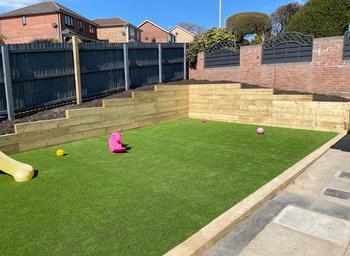
If you’re on a tight budget, a wooden retaining wall is likely to be your cheapest option. Choices range from rustic logs to sleek, pressure treated planks. Simple to install, they’re a relatively straightforward DIY project, provided you put in a little research and are willing to get stuck in with some heavy lifting and perhaps have some help on hand. Once you know how, there’s nothing to stop you landscaping your garden to complete the look with raised beds, steps, path or lawn edging built from railway sleepers or timber logs.
Chunky railway sleepers can last up to 20 years or more with regular treatment and maintenance. However, timber that’s in contact with wet soil will always be prone to rot, so check for wear and tear regularly. Choose pressure treated wood to help improve longevity.
Concrete block walls are cheap and quick to build
A quick and cost-effective method of construction for your retaining wall, concrete breeze block walls can be left as they are, painted or plastered with render to give a smooth appearance. They have longevity and can last over 100 years with maintenance on any exterior finish you use.
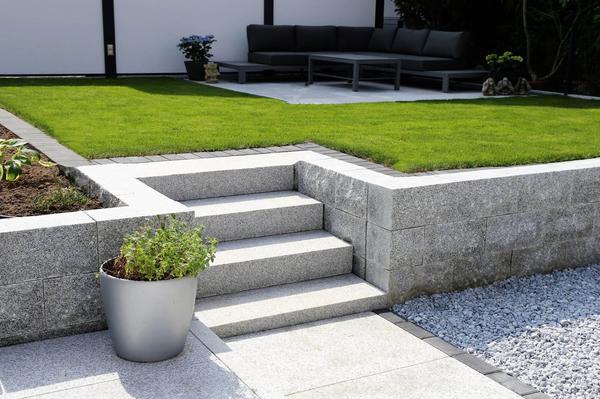
Adding a solid structure to a slope will change the flow of water downhill, so be sure to install adequate drainage pipes and weep holes to allow water to escape. To add structural support, you may want to consider using reinforcing metal bars (rebars) set into the footing. Careful research is needed before opting to go down the DIY route when building a concrete wall – if in doubt, call in the professionals.
Brick garden walls for a traditional look
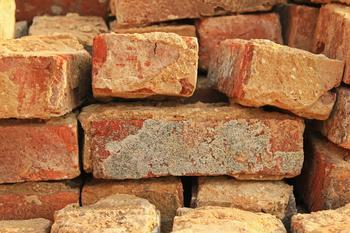
A classic brick retaining wall is a good option to choose if you’re going for low maintenance and longevity. Tie the look in with your house by using new or reclaimed bricks that are a close match with existing brickwork. If you’re going for a walled garden or the ‘cottagecore’ look, a traditional brick wall can really make an impact, especially if complemented with patterned brickwork paths and patios. However, bear in mind that simple house bricks may not always be suitable as retaining brick walls are constantly in contact with moist soil and can be prone to saturation and freeze-thaw action. Look out for the FL classification when researching your materials:
- F1 – Frost resistant bricks, best for retaining walls
- F2 – Moderately frost resistant bricks
- F0 – Not frost resistant
If you’re considering reclaimed bricks – find out if they have been used externally, as this is a good guide as to whether they will be frost resistant.
The thickness of your retaining wall also needs to be carefully researched and it may need to be constructed of a double skin layer of bricks. There are several methods of both construction and strengthening (with wall ties or similar) to consider. Search for a good brickie with landscaping experience, as they will have the know-how to advise you.
Poured concrete retaining walls offer strength
A poured concrete retaining wall can give an architectural edge to your garden. Although it’s a less common material for use in gardens, it’s worth consideration as concrete is both longer lasting and lower maintenance than timber, and much stronger than hollow concrete breeze blocks. Poured concrete can last over 100 years.
Depending on the height of your wall, it may be poured in stages. If you’re tackling this job yourself, you will need to research the correct thickness to use and how to tie the layers together for structural integrity. The downside with this method of construction is that faults in the wall can’t be seen until the wall is dry. To avoid costly mistakes, call a builder or opt for a similar look which is achievable with simple breeze blocks and plaster or render.
Concrete can be coloured or textured, with finishes either being stamped on the surface to mimic stone, timber or brick, or hand sculpted by carving out patterns. Or you may want to keep things simple and lean into the industrial nature of layered concrete, by opting for an unfinished or polished surface that exposes the original minor imperfections and textures of the material.
Add style to your retaining wall with stone veneer or cladding
This is more of a finishing layer to a brick or concrete retaining wall – ideal if your existing retaining walls are in good condition but you want to give them a makeover, or if you’re on a budget. There’s a nearly endless selection of stone cladding and brick slips on the market, which can give your garden a designer look. Thin stone or brick veneers are simply adhered to the surface of your wall. These don’t necessarily add to its structural integrity and are purely decorative.
Adding cladding to a short retaining wall is a relatively simple DIY task, if you feel like having a go yourself. But research and preparation are key, as you’ll need to take time to strip any existing paint or render finishes off your wall and smooth out the lumps and bumps before you start.
Gabion retaining walls for a DIY project
Creating a striking, industrial look, gabion walls have had a renaissance over the past few years thanks to their budget price point and relative ease of construction. Made from sturdy wire cages filled in with rough stone, they are a hefty landscaping feature that can be installed with a little DIY know how and last over 50 years, with care.
If you’re planning to DIY your wall, you’ll need to factor in the time it will take to construct your baskets, as they are usually delivered flat-packed. This is simple to do, but fiddly and time consuming. Filling the baskets may also take a bit longer than you think as it’s best to avoid dumping them in by the barrow load. The rocks need to be carefully hand-arranged, packing them close together, avoiding gaps to provide stability and to achieve an aesthetically pleasing look. However, you won’t need to install drainage as gabions offer great natural drainage.
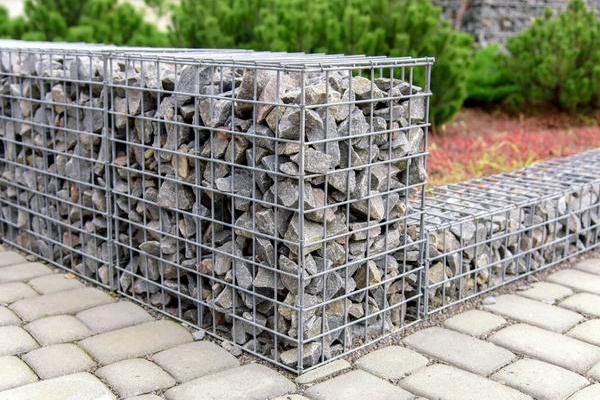
There’s no limit to the different combinations of texture and colour you can choose for your stones – for example you could tie it to your landscape by using a local stone. The look can also be softened by adding some soil in places to grow plants. A bit like playing with giant Lego®, gabion walls can be used to construct seating or even steps if slabs or planks are secured on top.
Boulders and natural stone take your wall back to nature
Natural stone is a great choice for a retaining wall. It’s a lifetime product that should last up to 100 years and have natural drainage when stacked or constructed using a dry stone wall techniques. But, dry stone techniques are only recommended for shorter walls and you still need to think about adding some structure for strength. This means prepping the foundations for a stable base and laying ‘deadmen’ stones intermittently along the width as you go - these are longer anchoring stones set perpendicular to the wall, projecting into the infill area behind it.
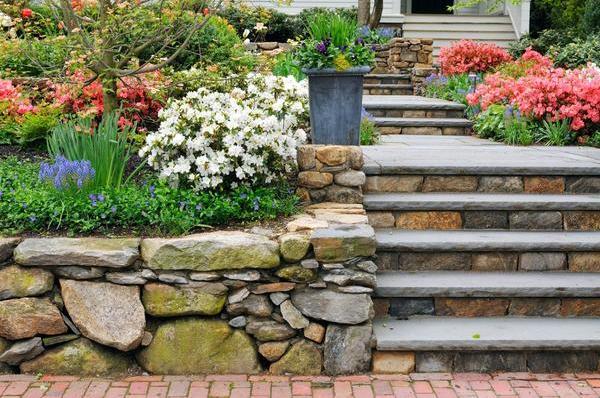
Play with scale. Oversized boulders are low maintenance and work well in a woodland style garden and can form natural steps, stabilise a planted slope or be part of a water feature.
Do I need planning permission for a retaining wall?
The rules that apply in England state that you will need to apply for planning permission if the wall you are building is over two metres high, or one metre high if it’s next to a road or pathway. If the wall is free standing (and not attached to another structure) building regulations won’t apply, but it must be structurally sound and it will need to be well maintained. There are certain circumstances under which these rules do not apply. For example, there are tighter regulations for listed properties and any land that adjoins them, and also within the boundaries of protected areas such as National Parks.
If you are building a retaining wall within 3.7m of a street, you should also seek advice from your Local Authority (or from the Highway Authority if your road is adopted - ie, a formerly private road which your County Council has adopted and now maintains).
Before any work starts, make sure you check the Planning Portal’s advice on garden walls. Rules in Scotland, Wales and Northern Ireland vary.
Find someone to build a retaining wall for you
If you don’t want to take on a DIY project or need professional advice about retaining walls, it may be time to look for a landscape gardening company who can help you. Use our Find a Builder search tool to look for local building companies that specialise in landscape gardening, and get in touch today.
Feeling inspired? Take a look at our other sloping garden ideas on our homeowner blog.

